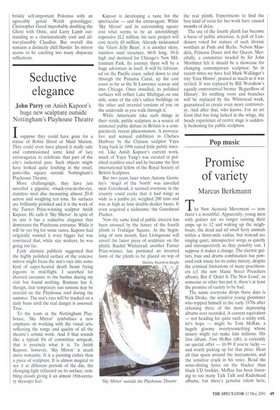Seductive elegance
John Parry on Anish Kapoor's huge new sculpture outside Nottingham's Playhouse Theatre
Isuppose they could have gone for a statue of Robin Hood or Maid Marion. They could even have played it really safe and commissioned some kind of lacy extravaganza to celebrate that part of the city's industrial past. Such objects might have looked quite fetching in the small, patio-like square outside Nottingham's Playhouse Theatre.
More challengingly, they have just unveiled a gigantic, whack-you-in-the-eye, stainless steel disc measuring almost 20-ft across and weighing ten tons. Its surfaces are brilliantly polished and it is the work of the Turner Prize-winning sculptor Anish Kapoor. He calls it 'Sky Mirror'. In spite of its size it . has a seductive elegance that dominates the Playhouse entrance. While it will be too big for some tastes, Kapoor had originally wanted it even bigger but was convinced that, while size matters, he was going too far.
Early alarmist publicity suggested that the highly polished surface of the concave mirror might focus the sun's rays into some kind of super-heated death beam frying pigeons in mid-flight. I searched for charred carcasses in the bushes during my visit but found nothing. Rumour has it, though, that temporary sun screens may be erected on the Playhouse roof during the summer. The sun's rays will be tracked on a daily basis until the real danger is assessed. True.
To the team at the Nottingham Playhouse, 'Sky Mirror' symbolises a new emphasis on working with the visual arts, reflecting the range and quality of all the theatre's artistic work. And if that sounds like a typical bit of committee artspeak, that is precisely what it is. •To Anish Kapoor. however, 'Sky Mirror' is much more romantic. It is a painting rather than a piece of sculpture. It is almost magical to see it at different periods of the day, the changing light reflected on its surface, tumbling clouds giving it an almost 18th-century skyscape feel. Kapoor is developing a taste for the spectacular — and the extravagant. While 'Sky Mirror' and its surrounding square cost what seems to be an astonishingly expensive £1.2 million, his next project will cost nearly £6 million. Already nicknamed the 'Giant Jelly Bean', it is another shiny, stainless steel structure, 60-ft long, 30-ft high and destined for Chicago's New Millennium Park. Its journey there will be a huge adventure in itself. It will be fabricated on the Pacific coast, sailed down to and through the Panama Canal, up the east coast as far as the St Lawrence seaway and into Chicago. Once installed, its polished surfaces will reflect Lake Michigan on one side, some of the city's tallest buildings on the other and inverted versions of you on the underside as you walk through it.
While Americans take such things in their stride, public sculpture as a source of animated public debate in Britain is a comparatively recent phenomenon. A provocative and sensual exhibition in Chelsea Harbour by the Chinese sculptor Yuyu Yang back in 1996 raised little public interest. Like Anish Kapoor's current work, much of Yuyu Yang's was created in polished stainless steel and he became the first international fellow of the Royal Society of British Sculptors.
But two years later when Antony Gormley's 'Angel of the North' was unveiled near Gateshead, it seemed everyone in the country could recite that it had wings as wide as a jumbo jet, weighed 200 tons and was as high as four double-decker buses. It even acquired a nickname: the Gateshead Flasher.
Now the same kind of public interest has been aroused by the future of the fourth plinth in Trafalgar Square. At the beginning of next month, Ken Livingstone will unveil the latest piece of sculpture on the plinth. Rachel Whiteread. another Turner Prize-winner, has promised an inverted form of the plinth to be placed on top of the real plinth. Experiments to find the best kind of resin for her work have caused months of delay.
The use of the fourth plinth has become a focus of public attention. A poll of Londoners voted for statues of such diverse worthies as Posh and Becks, Nelson Mandela, Princess Diana and the Queen. Mercifully, a committee headed by Sir John Mortimer felt it should be a showcase for changing contemporary sculpture. So in recent times we have had Mark Wallinger's tiny `Ecce Homo', praised as much as it was reviled, It was replaced by Bill Woodrow's equally controversial bronze 'Regardless of History'. Its writhing roots and branches will be replaced by the Whiteread work, guaranteed to create even more controversy. And after that, who knows. For an art form that has long lurked in the wings, the heady experience of centre stage is suddenly beckoning for public sculpture.


































































 Previous page
Previous page